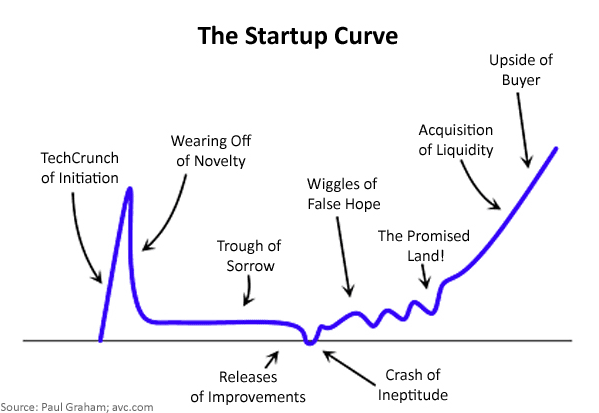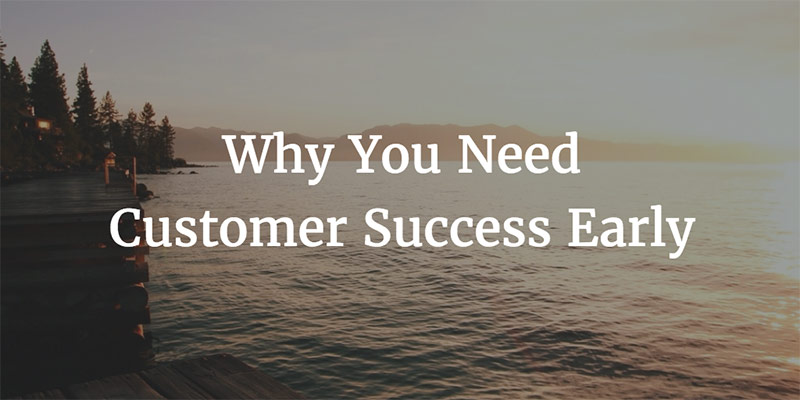You might not know this, but People.ai isn’t my first company. I actually founded a previous company, Semantria, which built the world’s first massively scalable sentiment analysis cloud service. Semantria was successfully sold to text analytics company Lexalytics in 2014.
While I’m proud of what my team and I were able to accomplish at Semantria, as with many first-time founders, I made my share of mistakes. In particular, I didn’t hire a customer success pro early enough, and that impeded Semantria’s early growth.
Before I dive any further into what I did wrong, and what I should have done differently, it’s worth highlighting the typical lifecycle of a startup. Paul Graham’s classic “startup curve” retains its accuracy.

In particular, I want to focus on the first three stages: “TechCrunch of Initiation,” “Wearing Off of Novelty” and “Trough of Sorrow” because it’s these that are important to the story. During Semantria’s TechCrunch of Initiation we quickly onboarded numerous new accounts as the company benefited from positive media buzz. Many prospects were intrigued by the idea that they could get sentiment analysis in a matter of minutes for less than $1,000; technology which was previously available only as on-prem software for large companies and required expensive servers, on top of the $100K a year or more in licensing costs.
It was an incredible and exhilarating time but our rapid growth also left us vulnerable to the usual growing pains. During the TechCrunch of Initiation every company enjoys the buzz that comes with the novelty of having a new product on the market. Silicon Valley is full of innovators and early adopters eager to try out what might be the next big thing. But things eventually change. New startups are founded or emerge from stealth and the aura of novelty naturally passes to them. Suddenly you aren’t getting a flood of inbound interest and have to cultivate your existing contacts and proactively reach out to new prospects in order to grow.
That’s exactly what happened to us at Semantria. Unfortunately, without a dedicated customer success professional we lacked the internal resources to properly nurture the large number of accounts we onboarded during our TechCrunch of Initiation. As the Wearing Off of Novelty inevitably passed into the Trough of Sorrow we weren’t able to support and retain all of the accounts that we had onboarded in our first stage as company. The problem was that as a small startup we didn’t have enough people to give each account the attention they deserved. I’m confident that if we had had someone who was 100% focused on customer success this could have been avoided.
Now, everyone knows that your existing customers are important. According to Inc “acquiring new customers is expensive (five to ten times the cost of retaining an existing one), and the average spend of a repeat customer is a whopping 67 percent more than a new one [emphasis added].” However, as a young company the key is to remember how important your existing customer base is, and to invest in internal resources accordingly. In particular, companies need to focus on churn metrics from day one.
For a SaaS model I look at the major periods in a customer life cycle as follows:
- Customer Onboarding
- First 90 Days (Higher-Touch Period)
- Rest of the Year (Lower-Touch Period)
- Last 90 Days Before Renewal (Higher-Touch Period)
During periods two and four having a full-time customer success professional around to assist customers as they learn to use your product and to reignite customer love for your product 90 days before renewal is absolutely critical. This may seem obvious, and more and more companies are taking notice by hiring customer success professionals, but when you’re a small company looking to minimize your burn rate a customer success professional can seem like an unnecessary luxury.
Trust me. It’s not. In today’s world of SaaS delivery models and extensive customer choice you have to continually deliver value to customers, not just at the point of sale. Looking back, if there was one thing I could tell myself when I first founded Semantria it’s that every dollar spent on customer success will earn a tenfold return over a customer’s lifecycle. As a more experienced founder I knew that I wanted to hire customer success early at People.ai and I’ve been impressed by the results that our customer success manager has delivered within just a few weeks of joining our company.
I hope it doesn’t take you until your second company to learn from my mistake. Take it from me and add customer success to your team early!

